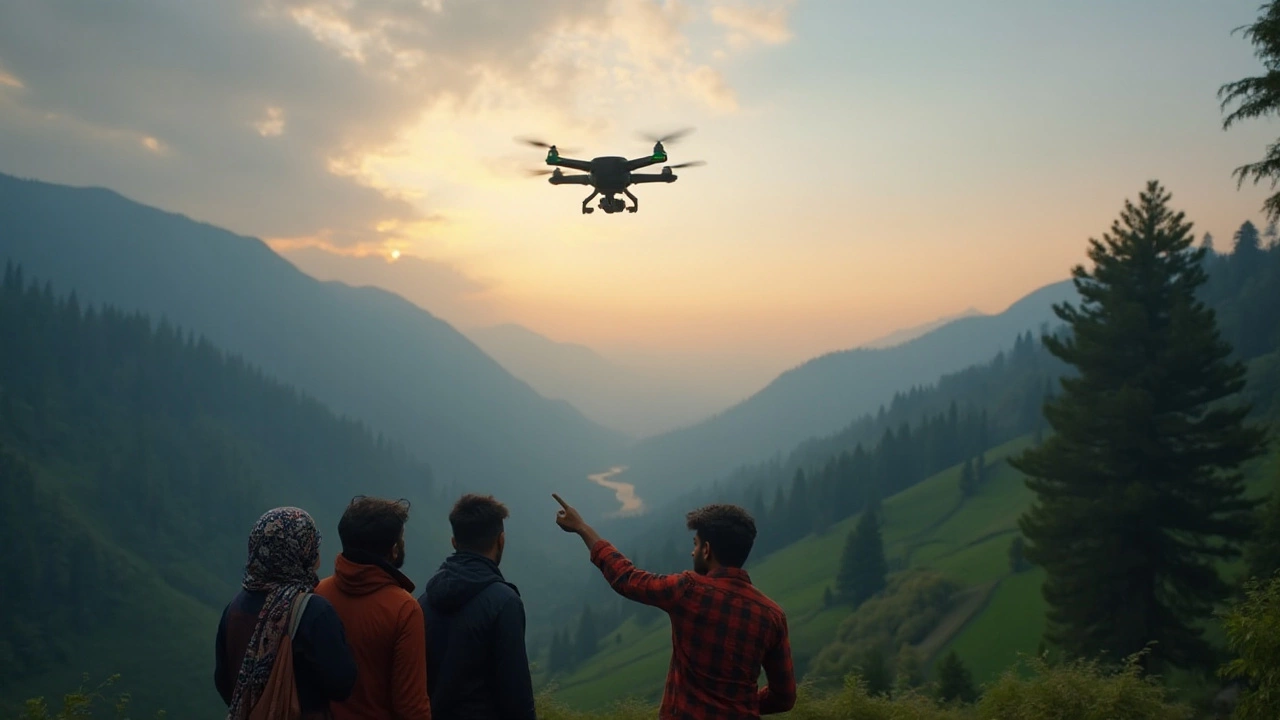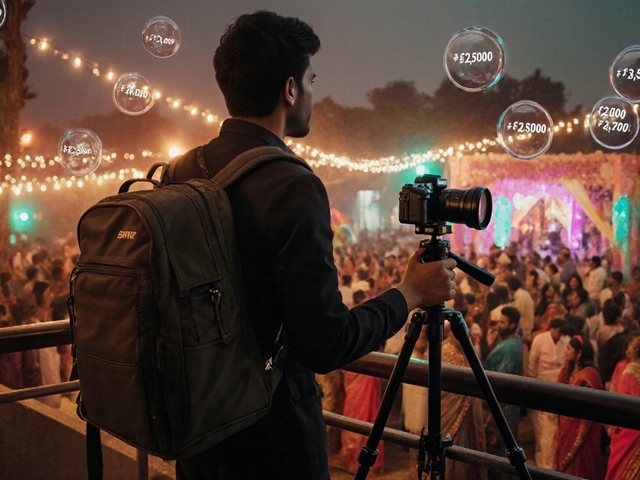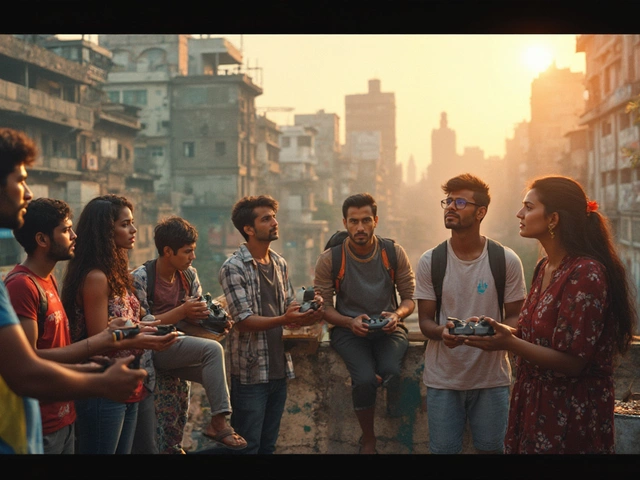The allure of capturing Kashmir's majestic landscapes from above is undeniable. Drones have become an essential tool for photographers seeking to explore new heights and angles. However, navigating the skies of this region requires an understanding of strict aviation rules that govern drone usage.
In India, flying a drone isn't just about having the latest equipment; it's about ensuring compliance with laws that prioritize safety and security. Kashmir, with its unique geopolitical context, has even more specific guidelines to follow. This article will guide you through what's needed before you launch your drone in this breathtaking paradise.
- Understanding Drone Regulations in India
- Specific Rules for Operating Drones in Kashmir
- Permission and Licensing Requirements
- Safety Tips for Drone Photography in Kashmir
- Best Locations for Drone Photography
- Legal Consequences of Rule Violations
Understanding Drone Regulations in India
Flying drones in India involves navigating a complex set of rules and regulations that have been established to ensure safety, security, and privacy. The Directorate General of Civil Aviation (DGCA) is the governmental body overseeing these regulations. In India, drones are categorized based on their weight, ranging from nano drones to large drones, and each category is subject to specific operational rules. For most photography enthusiasts, the focus usually lies on micro and small drones, which are used for capturing high-quality images and videos.
Before taking to the skies, individuals must first register their drones through the Digital Sky platform, a government initiative to facilitate unmanned aerial vehicle operations. This process requires providing detailed information about the drone and its owner, and obtaining a Unique Identification Number (UIN) and an Unmanned Aircraft Operator Permit (UAOP) if necessary. The DGCA also uses a 'No Permission, No Takeoff' (NPNT) protocol, which mandates real-time permission before every flight, ensuring that all operations are monitored and controlled.
Flying drones also entails understanding the no-fly zones clearly demarcated across the country. Areas near airports, military bases, and national borders are typically restricted, and flying in these zones can lead to severe penalties. Kashmir drones, in particular, are subject to additional scrutiny due to the sensitive nature of the region. Operators must be vigilant about maintaining a safe distance from sensitive locations and avoiding any activities that could be perceived as intrusive or threatening.
The DGCA states, "Safety and security form the cornerstone of the drone regulations, balancing innovation with public interests."
Apart from the regulatory framework, drone pilots must also adhere to strict operational guidelines during flights. These include maintaining visual line-of-sight, flying only during daylight, avoiding populated areas, and using drones only in good weather conditions. Failure to comply with these guidelines can result in fines, legal action, or even confiscation of the drone. Drone users interested in India photography should thus be meticulous in their preparations to avoid unforeseen legal entanglements.
The entire regulatory ecosystem is designed to foster safe and innovative use of drones while safeguarding public safety and national security. With more than 85% of Indian airspace available for drones, there are ample opportunities for operators who comply with regulations. Adherence to the guidelines not only prevents legal issues but also paves the way for more advancements and opportunities in the field of drone photography, making it a worthwhile endeavor for enthusiasts across the country.
Specific Rules for Operating Drones in Kashmir
Flying a drone in Kashmir involves navigating through a maze of rules and regulations that reflect both national and local concerns. In India, the regulatory framework for drones is primarily governed by the Directorate General of Civil Aviation (DGCA). These rules are designed to ensure the safety and security of airspace, especially in sensitive regions like Kashmir. The DGCA categorizes drones based on weight, and operators must comply with the relevant regulations for their specific drone class. For enthusiasts and commercial operators, awareness starts with knowing that drone flying is not just a leisure activity; it's subject to stringent legal oversight.
In Kashmir, additional restrictions apply due to its unique geopolitical situation. The region's strategic importance means that drone operations are more tightly monitored. Operators need to secure permissions from local authorities, especially in areas categorized as 'No Drone Zones'. These include sensitive military locations, near airports, and other critical infrastructure where unauthorized flights are strictly prohibited. The application process involves providing detailed information about the drone, including its specifications, intended flight path, and specific usage.
Security clearance is vital. Drone operators must engage with the local police, particularly if the drone is to be used for commercial purposes or in areas with restricted access. This step ensures that drones do not compromise the region's security protocols. As per recent guidelines, it's crucial for operators to maintain a direct line of sight with the drone at all times and avoid flying over crowds to prevent privacy invasions. The importance of respecting people's privacy cannot be overstated, and any violation might lead to confiscation of equipment along with stiff penalties.
"Operating drones in scenic but sensitive regions such as Kashmir requires utmost responsibility and compliance with the regulatory norms," as emphasized by the Director-General of the Indian Drone Association.
Given Kashmir's topography and unpredictable weather, safety becomes another critical factor. Wind can be particularly challenging in the mountainous regions, affecting stability and control. Many local hobbyists suggest avoiding flying on windy days and always checking the weather forecast beforehand. Having a pre-flight checklist can help assure everything from battery charge to camera settings is perfect, minimizing risks during the operation.
Another key point is insurance. It is advisable that drone operators secure appropriate insurance coverage to safeguard against potential damages or injuries caused during flight operations. This is not just a suggestion but increasingly becoming a mandate for various insurance policies, which cover both liability and accidental damage. Investing in a good quality drone with robust navigational aids is recommended, as it enhances the safety and quality of your drone photography experience.
Kashmir's breathtaking beauty is a strong lure for drone photographers, but operators need to balance their creative ambitions with legal responsibilities. Understanding the specific framework governing drone flights here ensures that enthusiasts can continue capturing its stunning landscapes without facing legal issues. Continuous updates on legal frameworks are provided by the DGCA's website and are crucial for ensuring that all drone operations remain within legal bounds. This keeps both operators and their subjects safe, fostering a friendly environment for innovation in aerial photography.
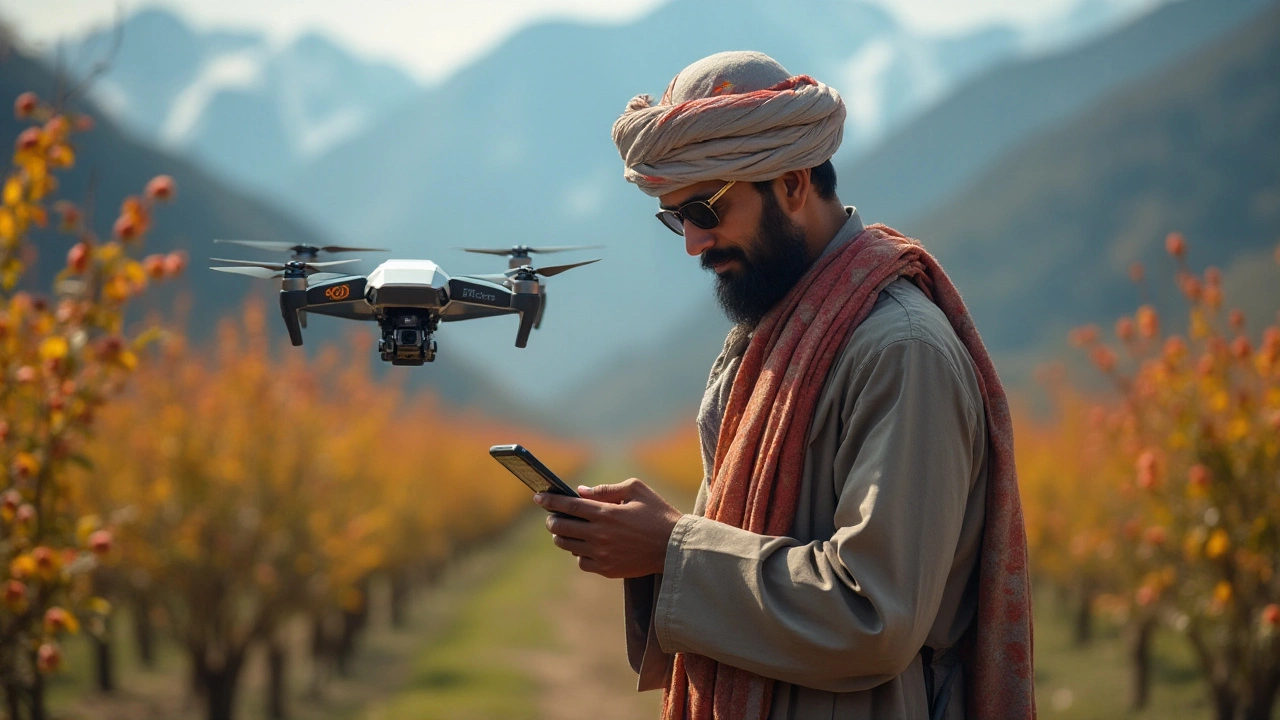
Permission and Licensing Requirements
Operating a drone in the lush valleys of Kashmir can be an experience like no other, but it does come with its share of bureaucratic hoops. In India, drones of varying sizes and capabilities are categorized into different classes, each requiring specific permissions from the Directorate General of Civil Aviation (DGCA). The DGCA's 'Drone Rules 2021' provides a comprehensive framework that's essential reading for anyone considering drone photography in India. Understanding these guidelines is key, as all drones over 250 grams necessitate a Unique Identification Number (UIN), akin to a registration plate for cars.
Before launching your drone in Kashmir, securing the correct permissions is a legal necessity. First, you'll need to obtain a UIN via the Digital Sky platform, a centralized online system set up by the DGCA to streamline drone operations and permissions across the country. The Digital Sky platform is, in many ways, your best friend when it comes to navigating the administrative landscape. You need to upload essential documentation, including your identification and details of the drone. The process has been made relatively simpler in recent times to encourage responsible usage while maintaining safety protocols.
Licensing doesn't end at registration, though. Instead, it's just the beginning. For drones meant for commercial use, such as professional filming or surveying, a Remote Pilot License (RPL) is also required. This necessitates training from a DGCA-authorized school. Given the diverse geography and sensitive airspace in Kashmir, most certifications include training in mapping terrain, understanding weather patterns, and local airspace restrictions. According to Surya Kumar, an officer at the DGCA, "The purpose of these regulations is to ensure that drones are used productively while also keeping a check on potential risks."
"Drones, when regulated appropriately, have the potential to revolutionize the way we view and interact with our world," says Bharat Singh, a noted aerial photographer.
If your hearts are set on capturing an aerial shot of Kashmir's iconic Dal Lake or the snow-clad peaks, bear in mind the need for a Permission to Fly (PTO) from local authorities. Kashmir's airspace is closely monitored due to its geopolitical sensitivity, and knowledge of restricted zones is critical. Always ensure that your flight paths steer clear of no-fly zones such as military installations or densely populated areas.
For ease of understanding, let's break down the steps required for legal drone operation in Kashmir:
- Register your drone on the Digital Sky platform to obtain a UIN.
- If flying commercially, receive your Remote Pilot License after completing the necessary training.
- Apply for a Permission to Fly with an authentic flight plan detailing your intended aerial exploration.
- Check for updates on restricted areas to avoid unexpected legal issues.
Patience and adherence to set regulations can lay the foundation for stunning drone captures, setting you up for a rewarding session of drone photography while respecting the complex legal and cultural landscape of Kashmir.
Safety Tips for Drone Photography in Kashmir
When it comes to flying drones in the mesmerizing landscapes of Kashmir, safety is a priority not just for the pilot but also for those below. Operating a drone in this region can be a rewarding experience, offering access to breathtaking vistas not visible from the ground. However, it's essential to ensure that every flight is conducted legally and safely. First, always check weather conditions—Kashmir’s weather can change unpredictably, and strong winds or rain aren't conducive to flying. Drones can be easily swept away or damaged if caught in adverse weather.
Understanding local laws is vital since Kashmir has specific regulations due to its sensitive geopolitical situation. It's advisable to familiarize yourself with the exact boundaries where drone flying may be restricted, often near military zones which are prevalent throughout the region. Notably, flying over populated areas or crowds should be avoided not just for safety but also for privacy concerns. Consulting any recent government advisories or local authorities can provide up-to-date restrictions or guidelines you must adhere to.
Securing proper permissions is another critical step. In India, even for hobby flying, you need to register your drone with the Directorate General of Civil Aviation (DGCA). For flights in areas like Kashmir, additional permissions from the local government or military might be necessary. Without these, you might face legal consequences such as fines or confiscation of your equipment. Preparation and diligence in obtaining the right permits can reduce friction and enhance your shooting experience.
"It's crucial to remember that drones aren’t just toys; they’re aircraft with the potential to cause harm if not used responsibly," said a seasoned drone pilot at a recent photography symposium.
In terms of best practices, always keep your drone within line of sight, and never fly higher than the permissible altitude, which is generally 400 feet. This not only helps maintain control over your drone but also ensures it stays clear of manned aircraft paths. Consider using a GPS with a map of no-fly zones in Kashmir, which can aid in avoiding restricted areas and plan your flights effectively.
Lastly, remember the importance of insurance. While it might seem an extra expense, having your drone insured can be invaluable in case of accidental damage or malfunctions, which are more common than one might think. Some companies even offer coverage specifically for liability in the event your drone causes damage to property or injury to a third party. These precautions might seem extensive, but they are geared towards maximizing both the safety and success of your drone photography adventures in Kashmir.
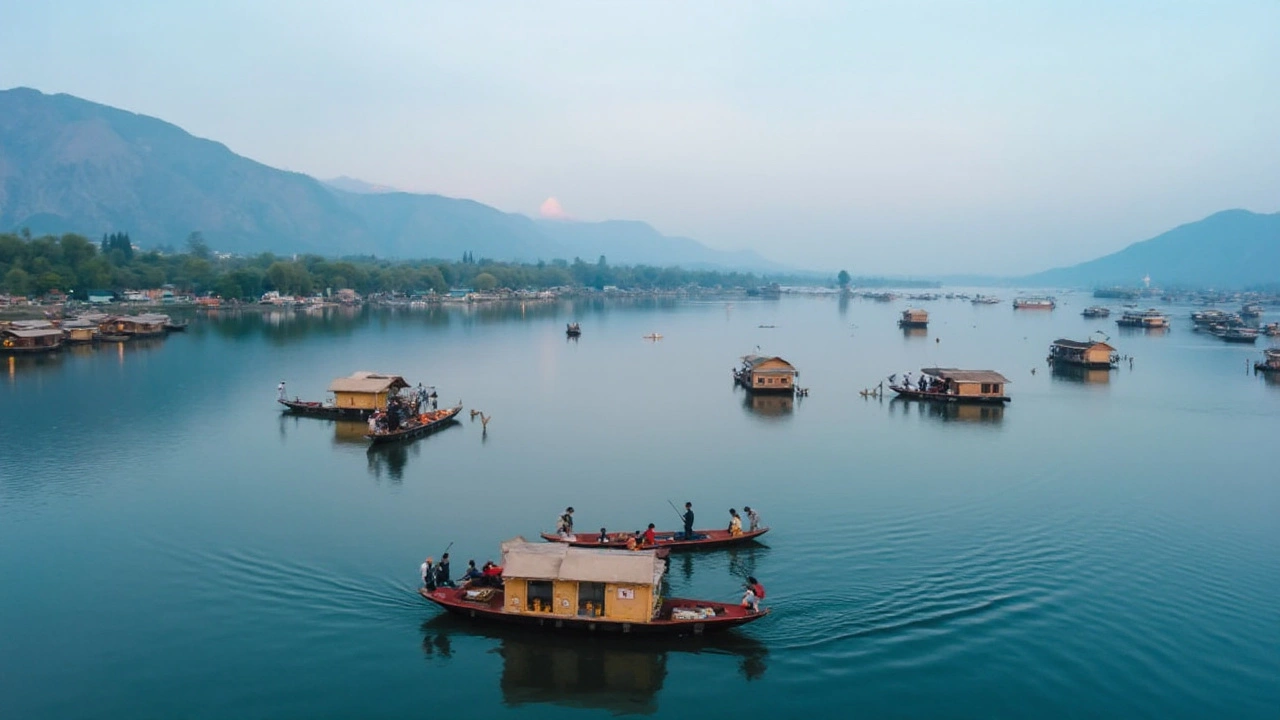
Best Locations for Drone Photography
Kashmir's unparalleled beauty has long drawn photographers and adventurers alike, and with the advent of drone technology, the possibilities for capturing its stunning landscapes have expanded exponentially. From the lush greenery of its valleys to the stark majesty of its mountainous regions, Kashmir provides a diverse array of subjects for drone photography enthusiasts. One of the prime spots to start your aerial adventure is the mesmerizing Dal Lake. Known for its serene waters and iconic houseboats, a drone can capture its vast expanse and the surrounding snowy peaks in a single, breathtaking shot. It's a popular spot, so it’s crucial to fly responsibly to avoid disturbing visitors or wildlife.
Another compelling location is Pahalgam, a quaint town nestled in the Anantnag district. Known for its lush meadows and trekking routes, Pahalgam offers a feast for the eyes with its picturesque settings that are perfect for both wide-angle shots and detailed close-ups of the natural habitat. Here, the undulating hills present an opportunity to capture dynamic landscapes. The region is also sprinkled with rustic villages that add an element of charm to the scenic beauty. Given its popularity with tourists, maintaining a low altitude and minimizing noise are key to ensuring an enjoyable experience for all.
The Majestic Gulmarg
Further along, Gulmarg, which means ‘meadow of flowers,’ is a must-visit for any drone photographer. Known for its vibrant fields of wildflowers set against a backdrop of towering peaks, this area offers a vibrant array of colors particularly in spring and summer. For a captivating experience, try filming at dawn or dusk when the light casts a magical glow over the snow-capped mountains and verdant meadows. Local laws dictate flying only during the day, but the ever-changing light can create myriad moods even then. Expect dramatic shifts in weather and always be prepared for the unexpected here.
"Kashmir’s ever-changing weather and iconic landscapes present unique challenges and opportunities for drone photographers. It’s essential to strike a balance between capturing the beauty and respecting the ecological and social boundaries." - Vijay Sharma, Indian Drone Photographer.
A visit to Kashmir would not be complete without exploring the historical town of Srinagar. Known for its historic architecture and lush gardens, a drone flight over Srinagar can reveal the harmonious blend of natural beauty and urban life. It's crucial to respect privacy and steer clear of sensitive areas, particularly military zones, to avoid any legal repercussions. Detailed knowledge of local airspace restrictions is critical here, given its proximity to national borders.
Finally, the stunning landscapes of Ladakh offer a stark yet beautiful contrast to Kashmir's lush valleys. Known for its arid desert climate and barren mountains, Ladakh is situated on the tibet plateau, offering unique textures and dramatic geological formations. Here, the barren beauty is raw and untouched, providing an extraordinary backdrop for aerial photography. Again, pay attention to airspace regulations, as several areas are demarcated as no-fly zones due to military activity.
Legal Consequences of Rule Violations
Navigating the skies of Kashmir with a drone offers unparalleled opportunities, but it also comes with a strict set of legal obligations. Understanding the legal implications of violating drone regulations is crucial for any enthusiast. Whether it's a professional photographer or a hobbyist, non-compliance can lead to severe consequences. Unauthorized drone operations may be perceived as a threat to national security, given Kashmir's sensitive geopolitical environment. Breaking the rules can result in hefty fines that might reach up to INR 1 lakh or more, depending on the severity of the infraction. In addition to financial penalties, those found guilty might also face criminal charges. This could involve lengthy legal processes and even imprisonment in extreme cases.
It's important to realize that the Indian Directorate General of Civil Aviation (DGCA) demands strict adherence to their regulations. The DGCA requires all civilian drone operators to acquire a valid Unmanned Aircraft Operator Permit (UAOP). Flying without this permit is risky. The local law enforcement agencies have the authority to seize any drones operated illegally and initiate prosecution against the operators. There have been instances where individuals found guilty of illegal drone usage in sensitive areas faced severe legal actions.
The Union Ministry's aviation guidelines explicitly mention, "Operating drones without proper authorization in restricted areas is treated as a serious offense under Indian law."Understanding this fundamental principle can save drone operators from unintended legal entanglements.
In the wake of these potential penalties, it becomes vital for drone operators to stay updated on any changes in the legal landscape. Kashmir's laws regarding drones are dynamic and can evolve with changing political and security scenarios. Subscribing to official channels and notifications from DGCA or local administrations can provide timely updates. Knowing before you fly is the key; otherwise, your aerial adventure could quickly turn into a legal nightmare. To safely enjoy the benefits of drone photography, always plan your flights with legal considerations in mind. Being informed and compliant not only ensures personal safety but also nurtures a culture of responsible drone usage in stunning locales like Kashmir.
